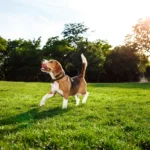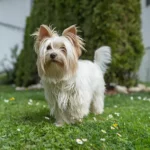Meet the Rottweiler: a strong, smart, and loyal dog. They started as cattle drivers in Germany and now are known for being great protectors and companions.
Cool Things About Rottweilers
- They’re really loyal to their families.
- Rottweilers are smart and like to learn new things.
- They need exercise and enjoy being active.
Life with a Rottweiler
Rottweilers do best with regular training and clear rules. They love having a job to do, like learning tricks or playing games. They fit well with families who can give them plenty of attention and activity.
This table provides a detailed profile of the Rottweiler breed, designed to help potential owners understand their specific needs and characteristics.
| Category | Detail |
|---|---|
| Breed Name | Rottweiler |
| Origin | Germany |
| Breed Group | Working (AKC), Guardian Dog (UKC) |
| Size Classification | Large |
| Weight Range | Males: 95-135 lbs (43-61 kg), Females: 80-100 lbs (36-45 kg) |
| Height Range | Males: 24-27 inches (61-69 cm), Females: 22-25 inches (56-63 cm) |
| Life Expectancy | 8-10 years |
| Coat Type | Short, dense, and straight |
| Coat Colors and Markings | Black with rust to mahogany markings |
| Grooming Needs | Low; occasional brushing and bathing |
| Shedding | Moderate; heavier during shedding seasons |
| Temperament | Confident, fearless, good-natured |
| Behavioral Tendencies | Protective instincts, territorial, can be aloof with strangers |
| Social/Behavioral Traits | Loyal and affectionate with family, good with children if raised with them |
| Activity Level | Moderate to high; requires regular exercise |
| Trainability | High; responds well to firm, consistent training |
| Intelligence Level | Highly intelligent, often used in police and military roles |
| Barking Tendency | Moderate; tends to bark with cause |
| Health Issues | Hip and elbow dysplasia, heart conditions, certain cancers |
| Dietary Needs | Balanced diet with controlled portions to prevent obesity |
| Suitability for | Experienced dog owners, active individuals, families with older children |
| Breed History | Originally bred to drive cattle and pull carts for butchers and farmers |
| Exercise Requirements | Daily walks, playtime, and mental stimulation |
| Space Requirements | Best with a yard; can adapt to larger homes with ample exercise |
| Sleeping Requirements | Typically 12-14 hours a day, including naps |
| Climate Adaptability | Adaptable but can be sensitive to extreme heat |
| Travel and Relocation Considerations | Adaptable but routine and familiarity are important |
| Compatibility Scorecard | City Living: 2/5, Families: 4/5, Novice Owners: 2/5, Exercise Enthusiasts: 4/5 |
| Ancestry and Bloodlines | Descended from Roman drover dogs |
| Notable Traits | Robust and powerful build, calm and confident demeanor, distinct black and tan markings |
| Role | Guard dog, police/military dog, service dog, companion |
| Care Requirements | Regular exercise, mental stimulation, early socialization, and training |
| Cost Breakdown | Food: $40-$80/month, Grooming: Minimal, Veterinary care: $300-$700/year, Training: $100-$300/course, Insurance: $30-$60/month |
| Training and Socialization | Essential from a young age to ensure a well-behaved adult dog |
| Time Commitment | Several hours per day for exercise, training, and companionship |
| Enrichment Activities | Advanced obedience, weight pulling, agility, tracking |
| Common Training Mistakes | Inconsistent training, not addressing protective instincts properly |
| Seasonal Care | Basic care; may need cooling in hot weather |
| Allergy Considerations | Not hypoallergenic; sheds moderately |
| Health Screening | Hip and elbow evaluation, cardiac exam, ophthalmologist evaluation |
| Insurance Recommendations | Coverage for breed-specific conditions and potential health issues |
| Mental Stimulation Needs | High; enjoys tasks that challenge their intelligence |
| Kennel Club Recognitions | AKC, UKC, FCI, and others |
| Breed Standards | Strong, powerful, and muscular body, confident and fearless demeanor |
| Litter Size | 8-12 puppies |
| Level of Protection | High; natural protective instincts make them excellent guard dogs |
| Participation in Dog Sports | Often successful in obedience, tracking, and protection sports |
| Noise Level | Can be vocal when alerting or if left alone for long periods |
| Odor Level | Low; regular grooming helps to keep them clean |
| Watchdog/Alarm | Excellent; very alert to their surroundings and protective of their home |
| Therapeutic Use | Sometimes used as therapy dogs due to their calm and confident nature |
| Cultural Significance | Known for their roles in search and rescue, police, and military work |
| Rescue Organizations | Rottweiler Rescue Foundation, R.E.A.L. Rottweiler Rescue |
| Certification and Testing | Recommended to have OFA or PennHIP certification for hips, and DNA tests for other inheritable conditions |
| FAQ Section | Q: Are Rottweilers good family dogs? A: Yes, with proper training and socialization. Q: How much exercise do they need? A: Daily exercise is essential for their well-being. Q: Can Rottweilers live in apartments? A: They can adapt if given enough exercise, but a house with a yard is ideal. |


